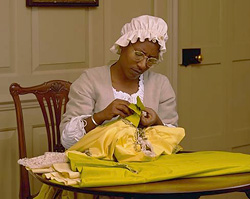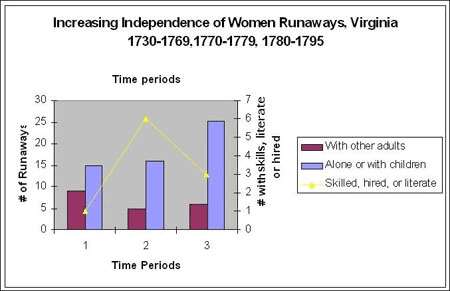Work of Enslaved Women in the Chesapeake
In West and West Central Africa women were the primary field workers. Men cleared fields for cultivation but women planted, sowed, hoed and harvested the crops. In the Chesapeake, although men were the primary field laborers, the majority of women worked as field hands in tobacco cultivation. In the Chesapeake, as they were in Africa, women were also responsible for childbearing, child rearing, maintaining the family garden, cooking for the family and care of their dwelling space. According to Kulikoff, citing Smith (1787), a mother would take her new infant to the fields with her “and lay it uncovered on the ground…while she hoed her corn-row down and up. She would suckle it a few minutes, and return to her labor (Smith in Kullikoff 1986:372).”
Family Group, Clarkson’s Quarter, Oxon Hill Plantation
| Jack Bruce age | 64 |
| Sarah wife to do | 56 |
| Henny daur. to Poll (a Mulatto 1) | |
| Anne do To do | 3 |
| Kate so. To Joan | 4 |
| Jenny do do | 3 |
| Nell | 30 |
| Nan Daugr. to Do | 7 |
| Isaiah Son do do | 5 |
| Priscilla Daugr. to do | 2 |
| Milley | 9 |
| Nan | 52 |
(Gunston Hall n.d., Addison 1775)
Enslaved women that lived in extended families structures or polygamous families could help one another to fulfill these work responsibilities. An older couple might have several small children living with them out on a quarter along with a mother and her small children. The extended family grouping of enslaved people living on “Clarkson’s Quarter” of Oxon Hill Plantation shown in the table on the left illustrates this type of living arrangement:
By mid-century, enslaved women learned to card wool, spin wool and flax, and to weave cloth. In 1771, William Lee an absentee Virginia planter ordered, “some of the Girls and infirm old women be taught to spin flax.” The Revolutionary War accelerated the domestic production of cloth, opening opportunities for more women to become skilled spinners and weavers. Four of the Nomini Hall’s weavers and 12 of the spinners were enslaved women. In 1775, William Cabell bound out his slave girl Aggy for six years in order that she might be taught the “art of Weaving.” After the war some planters continued to produce their own textiles as was the case on Edmound Randolph’s Virginia plantation where nine of fifteen women there worked as spinners, weavers, spinners, seamstresses, dairymaid’s, or nurses (Norton 1980:164–165; William Cabell Diary as cited in Morgan 1998:247–248).

(top) Bone and copper buttons from, slave site excavation, Carroll House, Annapolis MD. (bottom) Buttons from slave site excavations at Monticello, Virginia.
Scissors, pins, and buttons found in excavations of sites where 18th century Africans and African Americans lived and worked suggest that enslaved women sewed, probably clothes for themselves and their families or at least mended them (Walsh 1997:194–195; Samford 1996:111). A few became skilled seamstresses sewing clothes for other slaves and for the planter’s family.
Only two out of every ten enslaved women were domestics on the Washington, Jefferson, and Robert Carter of Nomini Hall plantations in the 1770s and 1780s. The end of the 18th century found that enslaved African American women on Carter’s plantation included ninety-seven field hands, six domestics, twelve spinners, seamstresses, weavers, and two women who were a nurse and midwife for other slaves (Kulikoff 1986:399)
Enslaved women worked at Chesapeake iron furnaces. Archeologists excavating a slave cemetery at Catoctin Furnace, Maryland unearthed thirty-one bodies. Six were newborns, five children (ages 2 to 12), two teenagers, and fifteen adults (consisting of eight females and seven males, between the ages of nineteen and sixty-five). Further examination by Smithsonian anthropologists revealed no European mixture among the group. The women’s average age at death was 34.6 years, longer than most enslaved people of the period (Bruston 1981; Kelley and Angel, 1983). Women also worked at the Oxford ironworks in Virginia. Oxford, established around the time of the Revolutionary War, by 1811 had 15 enslaved women workers. The women tended to receive less dangerous tasks that did not demand much strength and skill. None of them were forge hands, colliers, or molders. Most of the women at Catoctin and Oxford were family members of the men workers (Bezis-Selfa 1999:683–684).
Some enslaved women had multiple skills. They were field workers and could spin, weave, and do other domestic work. Being able to farm and having one or more saleable skills, fostered greater social autonomy in enslaved women, enhanced the possibility of their becoming economically independent and being able to survive as a free person. Sarah, was such a woman. Calling herself Sally Moss, she passed herself off as a free woman who ran “northward” in 1791.
“[Sarah was]”…so the advertisement for her read,…“an excellent house servant, as to spinning cotton of flax, sewing, knitting, cooking, washing, or any thing else a wench can do, and can work very well in the crop.” (Sarah, January 26, 1791, Geography of Slavery)
Domestic work roles exposed enslaved women to more acculturating experiences, particularly opportunities to become literate. Women who acquired skills and those hired out to work learned other lessons. They became aware of wages paid free laborers. Employers often forced hired enslaved women to provide for their own material needs and subjected them to unwanted physical relationships. The positive side of such deplorable living conditions was that enslaved women learned they did not have to depend upon a paternalistic “slave master’ to meet their everyday needs(Hughes 1978:26; Brown 2004b, Advertisements, Geography of Slavery).
While other factors undoubtedly contributed to women running away from slavery in the Chesapeake, the numbers of women running away from slavery alone or with their children as opposed to running away with a man, in unrelated or family groups greatly increased after 1760. Women who were literate, skilled, or had been hired out made up 27% of those running away alone or with their children between 1770–1779 (Brown 2004b, Geography of Slavery).








